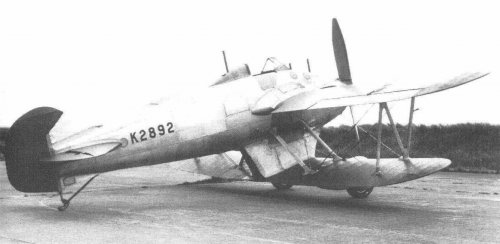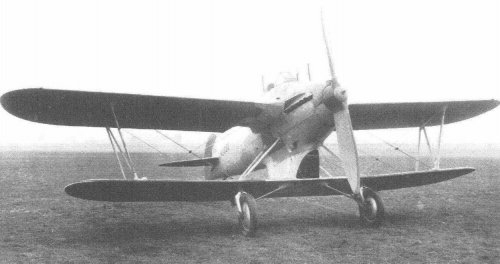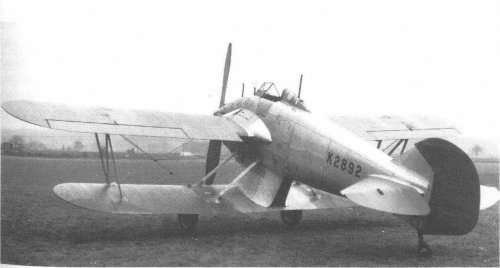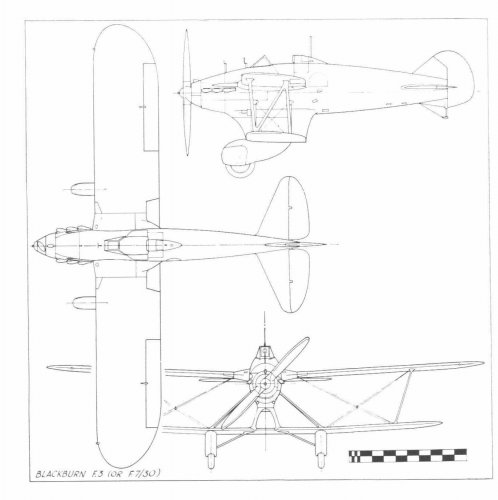Johnbr
ACCESS: Top Secret
- Joined
- 6 May 2007
- Messages
- 753
- Reaction score
- 329
It was the little biplane, which could be built around a 660-horsepower Rolls-Royce Goshawk III and based on the experience of the company with bodies flying boats, Petty used a covered working dural fuselage skin with integrated keel. The rest of the aircraft was a standard scheme for Blackburn - a cloth-covered steel and duralumin construction with having rogovyu compensation rudder. Upper wing had large scale and chord than the lower and carried ailerons, which, like the elevators were unbalanced.
Strange kind of built aircraft was due to the fact that the fuselage was raised from its normal position between the bearing surfaces to korobbka biplane was lower visual field pilot. Browse in the forward and upward was close to perfect as a streamlined nose zakapotirovannym Goshawk engine equipped with an exhaust system in front of a flame arrester cab was tilted sharply downwards. Special cell perokondensatory replace conventional radiators with coolant and were located in a streamlined tunnel, which, as in Blackburn Nautilus, the gap between the fuselage and the lower wing. Ratchet starter was mounted on a large two-bladed wooden propeller, through which all four machine guns through the mechanism of the interrupt fired. Two machine guns were located in the root portion of the upper wing, shooting through the tailpipes are located above the trough, and two others shot through the ports located on each side of the fairing capacitor.
Exceptionally wide track chassis consisted of two disk wheels installed in steel cantilever forks, shock absorbers, spring-applied oil and fastened with bolts directly to the front spar of the lower wing. Landing loads transmitted through the main structure ustanvolennye on each side parallel to the sloping front. The wheels were almost completely covered by large duralumin fairings on the tail of the plane has been set for a typical Blackburn reinforced skid.
Preliminary taxiing were performed in Breaux July 20, 1934 under EM Blake (AM Blake), and the corresponding ground operational testing began on 17 August. In their course revealed that the plane, as well as other motorized Goshawk prototypes suffer from problems with cooling. Another challenge was the difficulty of aircraft taxiways short fuselage and a high center of gravity removal and replacement fairings crutch on the wheel does not have much value. During the September 5 inspections were identified resulting from rulezhek cracks and dents in the metal fuselage skin.
Type Day and night interceptor
Manufacturer:Blackburn Aeroplane and Motor Co Ltd, Brough, East Yorkshire
Powerplant one 600-horsepower Rolls-Royce Goshawk III
Dimensions:
Wingspan 36 ft 10 dym (11.227 m)
length 27 ft 0 dym (8.23 m)
Height 10 ft 0 dym (3,048 m
Weight:
design 2500 lb (1134 kg)
Flight performance (estimated):
maximum skorot 190 miles / hour (305.71 km / h
Production: Only one aircraft K2892. First taxiing August 17, 1934, was not transferred to the balance of the Royal Air Force until 14 July 19 436 years. The same day, was removed from the balance sheet and transferred to the Office of Technical Development at No. 874M for use as a training airframe for heltonskoy school training in electrical and radio[/
Source: AJ Jackson "Blackburn Aircraft since 1909
Strange kind of built aircraft was due to the fact that the fuselage was raised from its normal position between the bearing surfaces to korobbka biplane was lower visual field pilot. Browse in the forward and upward was close to perfect as a streamlined nose zakapotirovannym Goshawk engine equipped with an exhaust system in front of a flame arrester cab was tilted sharply downwards. Special cell perokondensatory replace conventional radiators with coolant and were located in a streamlined tunnel, which, as in Blackburn Nautilus, the gap between the fuselage and the lower wing. Ratchet starter was mounted on a large two-bladed wooden propeller, through which all four machine guns through the mechanism of the interrupt fired. Two machine guns were located in the root portion of the upper wing, shooting through the tailpipes are located above the trough, and two others shot through the ports located on each side of the fairing capacitor.
Exceptionally wide track chassis consisted of two disk wheels installed in steel cantilever forks, shock absorbers, spring-applied oil and fastened with bolts directly to the front spar of the lower wing. Landing loads transmitted through the main structure ustanvolennye on each side parallel to the sloping front. The wheels were almost completely covered by large duralumin fairings on the tail of the plane has been set for a typical Blackburn reinforced skid.
Preliminary taxiing were performed in Breaux July 20, 1934 under EM Blake (AM Blake), and the corresponding ground operational testing began on 17 August. In their course revealed that the plane, as well as other motorized Goshawk prototypes suffer from problems with cooling. Another challenge was the difficulty of aircraft taxiways short fuselage and a high center of gravity removal and replacement fairings crutch on the wheel does not have much value. During the September 5 inspections were identified resulting from rulezhek cracks and dents in the metal fuselage skin.
Type Day and night interceptor
Manufacturer:Blackburn Aeroplane and Motor Co Ltd, Brough, East Yorkshire
Powerplant one 600-horsepower Rolls-Royce Goshawk III
Dimensions:
Wingspan 36 ft 10 dym (11.227 m)
length 27 ft 0 dym (8.23 m)
Height 10 ft 0 dym (3,048 m
Weight:
design 2500 lb (1134 kg)
Flight performance (estimated):
maximum skorot 190 miles / hour (305.71 km / h
Production: Only one aircraft K2892. First taxiing August 17, 1934, was not transferred to the balance of the Royal Air Force until 14 July 19 436 years. The same day, was removed from the balance sheet and transferred to the Office of Technical Development at No. 874M for use as a training airframe for heltonskoy school training in electrical and radio[/
Source: AJ Jackson "Blackburn Aircraft since 1909




